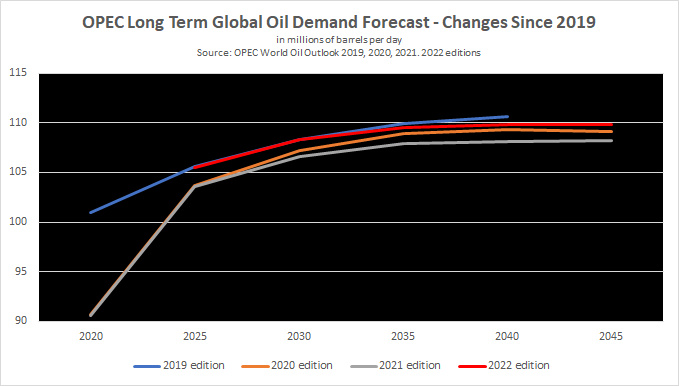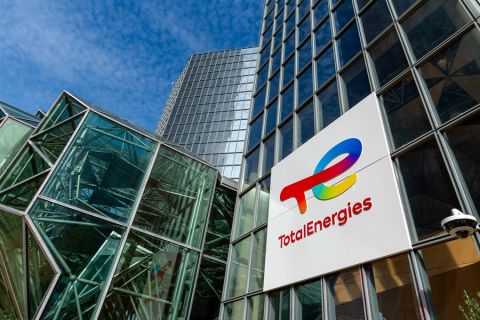OPEC raised its forecasts for world oil demand in the medium-and longer-term in an annual outlook released on Oct. 31 and said $12.1 trillion of investment is needed to meet this demand despite the energy transition.
The view from OPEC, in its 2022 World Oil Outlook, contrasts with that of other forecasters which see oil demand reaching a plateau before 2030 due to the rise of renewable energy and electric cars.
Another decade of oil demand growth would be a boost for OPEC, whose 13 members depend on oil income. The group has been arguing that oil should be part of the energy transition and that focus by investors on ESG issues has worsened an investment shortfall.
“The overall investment number for the oil sector is $12.1trillion out to 2045,” OPEC Secretary-General Haitham Al Ghais wrote in the foreword to the report, which said the figure was up from last year’s estimate. ”However, chronic underinvestment into the global oil industry in recent years, due to industry downturns, the COVID-19 pandemic, as well as policies centered on ending financing in fossil fuel projects, is a major cause of concern.”

OPEC made a shift in 2020 when the pandemic hit demand, saying it would eventually slow after years of predicting ever-increasing consumption. In the report, OPEC maintained its view that world demand will plateau after 2035.
Other predictions from companies and banks see oil demand peaking earlier.
The International Energy Agency on Oct. 27 for the first time in its history of modeling said demand for all fossil fuels was set to peak, with oil demand leveling off in the middle of the next decade.
Energy Security Demand Boost
The report said world oil demand will reach 103 million bbl/d in 2023, up 2.7 million bbl/d from 2022. The 2023 total demand is up 1.4 million bbl/d from last year’s prediction.
OPEC also raised its demand forecasts for the medium term to 2027, saying the figure is up by almost 2 million bbl/d by the end of the period from last year. It said the upward revision reflects a more robust recovery now seen in 2022 and 2023 and a “strong focus on energy security issues” leading to a slower substitution of oil by other fuels such as natural gas, whose price has soared due to Russia’s invasion of Ukraine.
By 2030, OPEC sees world demand averaging 108.3 million bbl/d, up from 2021, and lifted its 2045 figure to 109.8 million bbl/d from 108.2 million bbl/d in 2021. The group had lowered the 2045 projection over the last few years. OPEC and its allies, known as OPEC+, are again cutting supply to support the market.
The report sees supply restraint continuing in the medium term, with OPEC output in 2027 lower than in 2022 as non-OPEC supply grows. Still, OPEC is upbeat about its later prospects, seeing its market share rising. U.S. tight crude supply is seen peaking after the late 2020s, rather than around 2030 last year.
“Oil is expected to remain the number one fuel in the global primary energy mix,” the report said.
Indian minister urges OPEC+ to consider the impact on consumers at December meeting.
Recommended Reading
TotalEnergies to Acquire Remaining 50% of SapuraOMV
2024-04-22 - TotalEnergies is acquiring the remaining 50% interest of upstream gas operator SapuraOMV, bringing the French company's tab to more than $1.4 billion.
TotalEnergies Cements Oman Partnership with Marsa LNG Project
2024-04-22 - Marsa LNG is expected to start production by first quarter 2028 with TotalEnergies holding 80% interest in the project and Oman National Oil Co. holding 20%.
Is Double Eagle IV the Most Coveted PE-backed Permian E&P Left?
2024-04-22 - Double Eagle IV is quietly adding leases and drilling new oil wells in core parts of the Midland Basin. After a historic run of corporate consolidation, is it the most attractive private equity-backed E&P still standing in the Permian Basin?
Brett: Oil M&A Outlook is Strong, Even With Bifurcation in Valuations
2024-04-18 - Valuations across major basins are experiencing a very divergent bifurcation as value rushes back toward high-quality undeveloped properties.
Marketed: BKV Chelsea 214 Well Package in Marcellus Shale
2024-04-18 - BKV Chelsea has retained EnergyNet for the sale of a 214 non-operated well package in Bradford, Lycoming, Sullivan, Susquehanna, Tioga and Wyoming counties, Pennsylvania.




